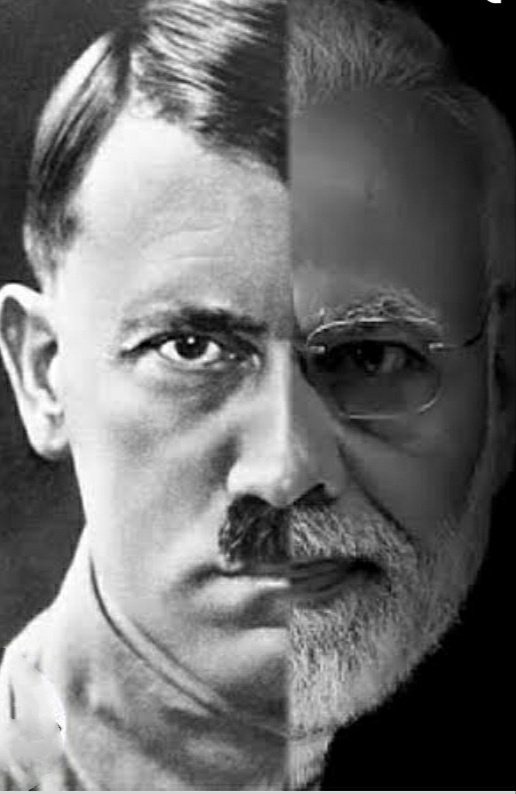From the year 2014 onwards, the religious nationalist Bharatiya Janata Party (BJP) government in India has been fueling the construction of a military-industrial complex and importing the most modern weapons. One can claim that the Prime Minister of India, Narendra Modi, is sketching a scenario that is based on the joining together of civilizational nationalism and the manufacturing of arms. The combination of these two forces is encouraging the population to prepare for a total war, which would serve the political goals and be a great honor. This development is not an isolated case; instead, it is in line with the grand strategy of the Third Reich. Nazi Germany, especially during the period from 1914 to 1941, was engaged in a combination of war, along with the use of ideological fervour, which eventually led to World War 2. Today, New Delhi is moving towards a similar combination of arms and assertive nationalism to achieve its political goals of becoming a hegemon. The shift from restraint to pre-emption, doctrinal hardness, and aggressive posturing can be analyzed through the convergence of arms ideology, which threatens the stability of South Asia.
After 1914, Germany’s strategic revolution can be understood within the broader relationship between state formation and warfare. More than the mechanized warfare, it was the product of a deeper fusion between ideological zeal and technological mastery. As Charles Tilly famously argued, war made states and states made war, suggesting that the administrative and coercive machinery of the modern state emerged from the imperatives of organised violence. Following the disillusionment of World War 1, German strategists sought to rebuild a unified practice of war that could reconcile the management of arms with the mobilization of national spirit. By the late 1930s, this dual evolution ensured that engineers optimised the tools of war, and while ideologues infused them with purpose and myths of supremacy. Motorised vehicles such as tanks, armored cars, and assault rifles were the means of a new era of technology and were even more so the symbols of this era. The entire process of combining the aspiration and technology, the passion and the accuracy, finally drove Germany into a catastrophic total war over the period of 1938 to 1941.
The military-industrial complex of India that is evolving under the leadership of PM Modi is akin to a state-driven quest for both strategic and economic freedom. The Atmanirbharta initiative, plus the enormous investment the government is making in defense production that covers everything from missile systems to drone technology, are all factors that together reinforce the national productive capacity. Moreover, defense exports and public-private partnerships have shown a remarkable increase that links industrialization with national pride. The rearmament policy of Germany in the interwar period, which depended on illegal industrial networks and foreign financing to set up rearmament, could be compared to the method employed in India.
The military modernization in India under PM Modi is not only a transition of the country to being politically centralized, technologically independent, and strategically aggressive. Prime Minister Modi’s Indigenous schemes, such as the establishment of a DRDO-Research base and the production of missiles, Agni-5 and Agni Prime being the latest ones, confirm the will of the defense industrial sector to reduce its reliance on foreign sources. Similarly, the Indian air and missile defense system is receiving a boost through its acquisition of sophisticated drone and radar technology from the US and Israel, Rafale fighters from France, and S-400 from Russia. The change from professional autonomy to strategic alignment with political power is reflected in the doctrinal changes that give importance to Integrated Theater Commands and the elevation of the Chief of Defense Staff. When all these evolutions are viewed together, they prepare New Delhi for a high-intensity conflict. The support of a unified nationalist vision for the BJP will come from all parts of society.
The mobilisation of a nation for an all-out war is a complex process. It requires mythmaking, war-memorization, and emotional rites to unite people in a moral community. For instance, in the interwar years, expansionist ideology, racial supremacy, and the idea of war as the will of the nation mobilised the German population. A similar thing can be said of India under Narendra Modi. By evoking stories of collective trauma, civilizational pride, and national regeneration as a moral and geopolitical need, it mobilises society. It has been slowly infiltrating the media, administration, educational institutions, and even the military since 2014. This will bring all facets of society together in support of a unified nationalist vision for the BJP. Strategically speaking, this consolidation communicates to its enemies a strong sense of national identity by projecting both internal strength and exterior resolve.
The military responses of New Delhi in 2016, 2019, and 2025 demonstrate the mutual reinforcement of military might and ideological conviction. Defense modernization is increasingly presented as evidence of the nation’s recovery, while the political narrative of Hindutva turns military gains into an affirmation of the power of civilisation. More risk-taking and risk tolerance follow from this mutually reinforcing cycle of belief and competence. India under Narendra Modi seems unafraid to risk escalation with a nuclear-armed neighbour, even though Pakistan has responded to each of these crises with measured and determined reactions. A desire to employ an escalatory strategy is demonstrated by the post-Pahalgam modernization and more aggressive official statements. India’s current course threatens the security balance of South Asia, much like Germany’s experience during the interwar period, when ideological fervour and technological ambition upset the European balance. To sum up, Narendra Modi’s Indian strategy is like Nazi Germany. The intersection of military modernisation, arms manufacture, and ideology renews a menacing overture. It mobilises and radicalises the populace to become more involved in the pursuit of ideological objectives. Unlike the reverse, this connection demotes goals below the means, which Nazi Germany exemplified. Consequently, the ideological conviction and motivation of the planners interfere with the rational process of strategic planning, thus resulting in escalation and destabilization. Peace and stability in the South Asian region are further endangered by India’s growing tolerance of risks and escalatory measures.
This article was published in another form at https://ipi.org.pk/history-revisited-ideological-militarism-from-berlin-to-new-delhi/
Muhammad Kumail Mehdi is a Research Assistant at the Center for International Strategic Studies in Islamabad.






